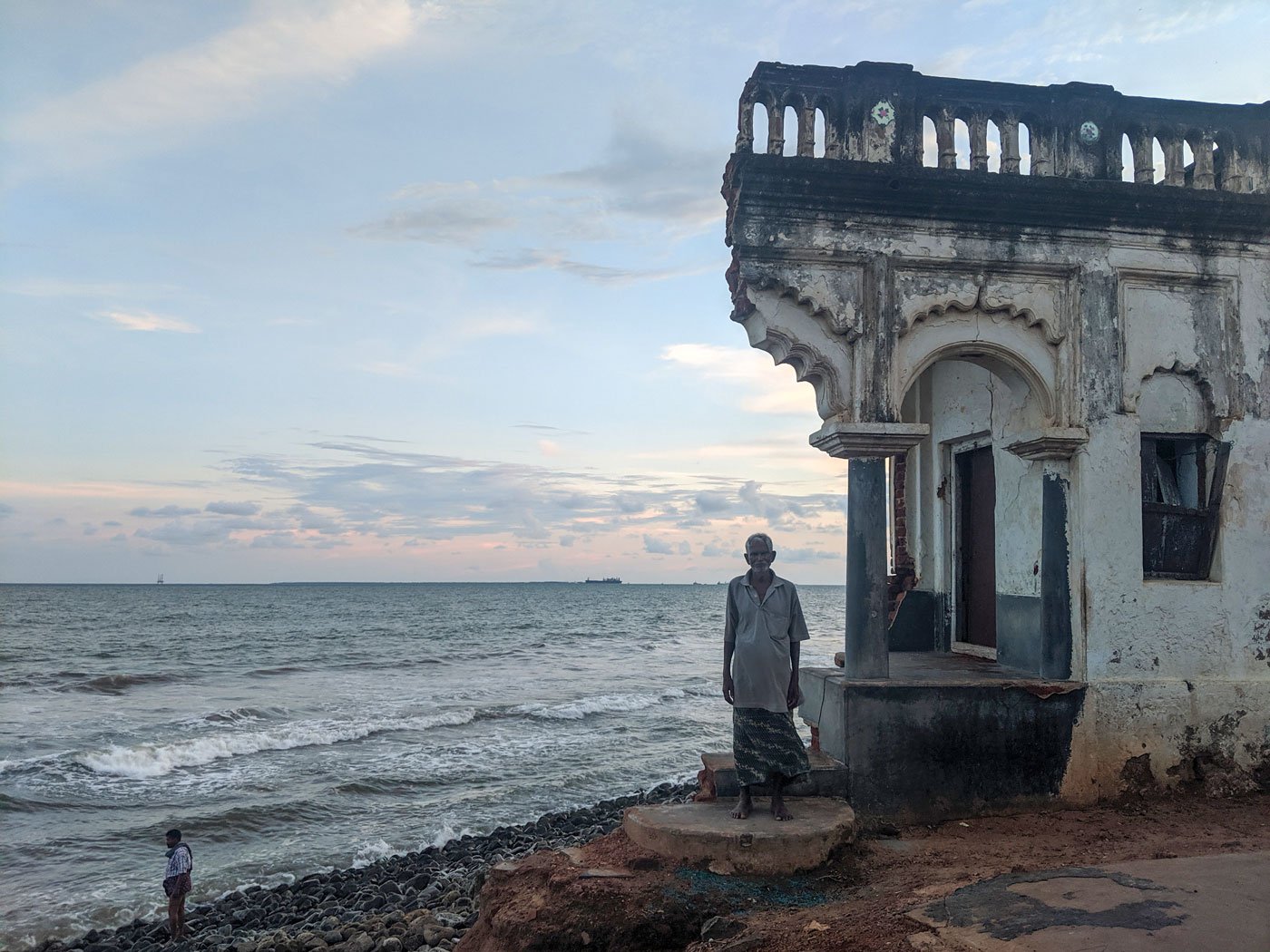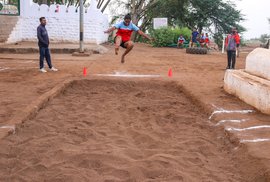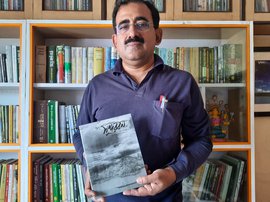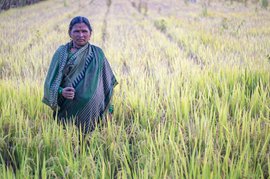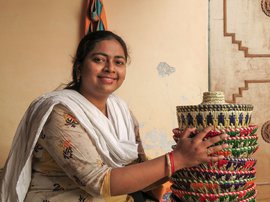Google Maps tells me I am approaching my destination. But the neighbourhood appears a bit altered from what I remember of it. There’s no sign of the crumbling old house by the sea, whose coordinates I had saved on my phone the last time I visited Uppada. “Oh, that house? It is in the sea now – there!” says T. Maramma, casually pointing to a wave gushing in from the Bay of Bengal.
I vividly remember the old structure that had offered a stunning, yet sombre, backdrop as I photographed Maramma and her family members a few weeks before the nationwide lockdown of March 2020. Perched perilously on a narrow beach, it was the only portion remaining of what used to be a large home where Maramma’s joint family lived until the early years of this century.
“It was a building with eight rooms and three sheds [for animals]. Around a hundred people used to live here,” says Maramma, a small-time local politician in her 50s, who once ran a fish business. A cyclone that hit Uppada just before the 2004 tsunami took away a big chunk of the building, forcing the joint family to move into different houses. Maramma continued to use the old structure for a few more years before shifting to a house nearby.
Maramma and her family are not alone; nearly everyone in Uppada seems to have moved home at least once because of the encroaching sea. Their calculations on when to quit a house are based on lived experience and the local community’s instinctive reading of the seas. “We can sense that the house will go into the sea when the waves start to bulge forward. Then we move our utensils and everything to one side [and start searching for a temporary house to rent]. The old house usually goes [into the sea] within a month,” explains O. Siva. At 14, he has already had to leave one house to escape the sea.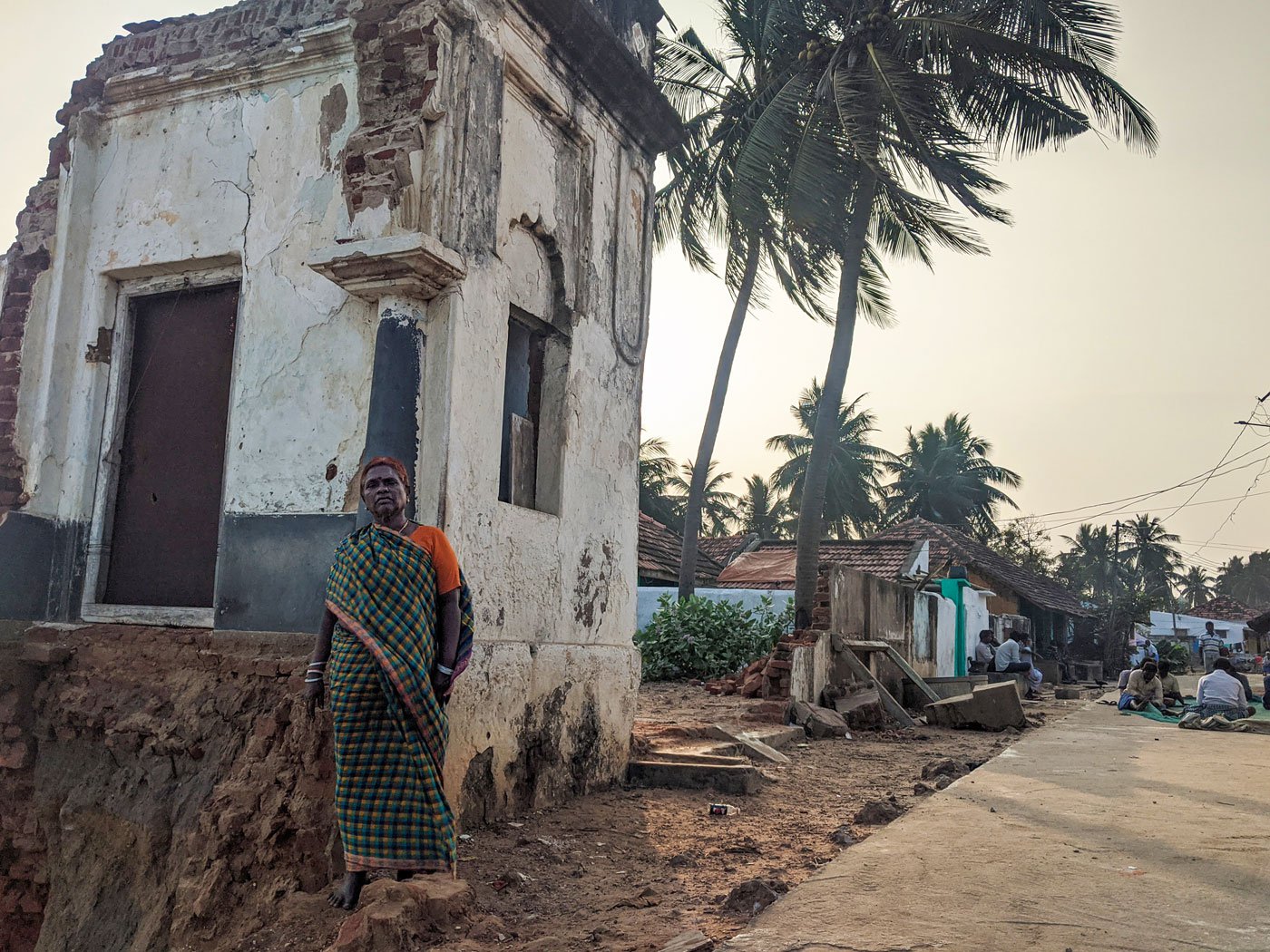
T. Maramma and the remains of her large home in Uppada, in January 2020 . Her joint family lived there until the early years of this century
*****
Located in East Godavari district, along the 975-kilometre coastline of Andhra Pradesh, Uppada has witnessed a steady onslaught by the sea for as long as its residents can remember.
When Maramma’s family moved into their then new home around 50 years ago, it was located far from the beach. “Our legs used to ache a lot when we walked home from the shore,” recalls O. Chinnabbai, Siva’s grandfather and Maramma’s uncle. A deep-sea fisherman in his 70s or 80s, he remembers a time when the stretch leading from their home to the beach was dotted with houses, shops and a few government buildings. “That was where the shore was,” Chinnabbai points towards a distant horizon where some ships fade into the evening sky.
“Between our new house and the sea, there was a lot of sand too,” Maramma reminisces. “When we were children, we would play in the sand mounds and slide through them.”
Much of the Uppada of these memories now lies submerged in the sea. Between 1989 and 2018, Uppada’s coastline eroded, on average, 1.23 metres every year; in 2017-18, the erosion was as much as 26.3 metres, says a study by researchers at the Andhra Pradesh Space Applications Centre, Vijayawada. Another study noted that over the last four decades the sea has claimed more than 600 acres of land in the Kakinada suburbs – with Uppada, in Kakinada division's Kothapalle mandal , alone losing around one-fourth of that. A 2014 study quoted fisherfolk living along the coast north of Kakinada as saying that the beach had shrunk by several hundred metres over the last 25 years.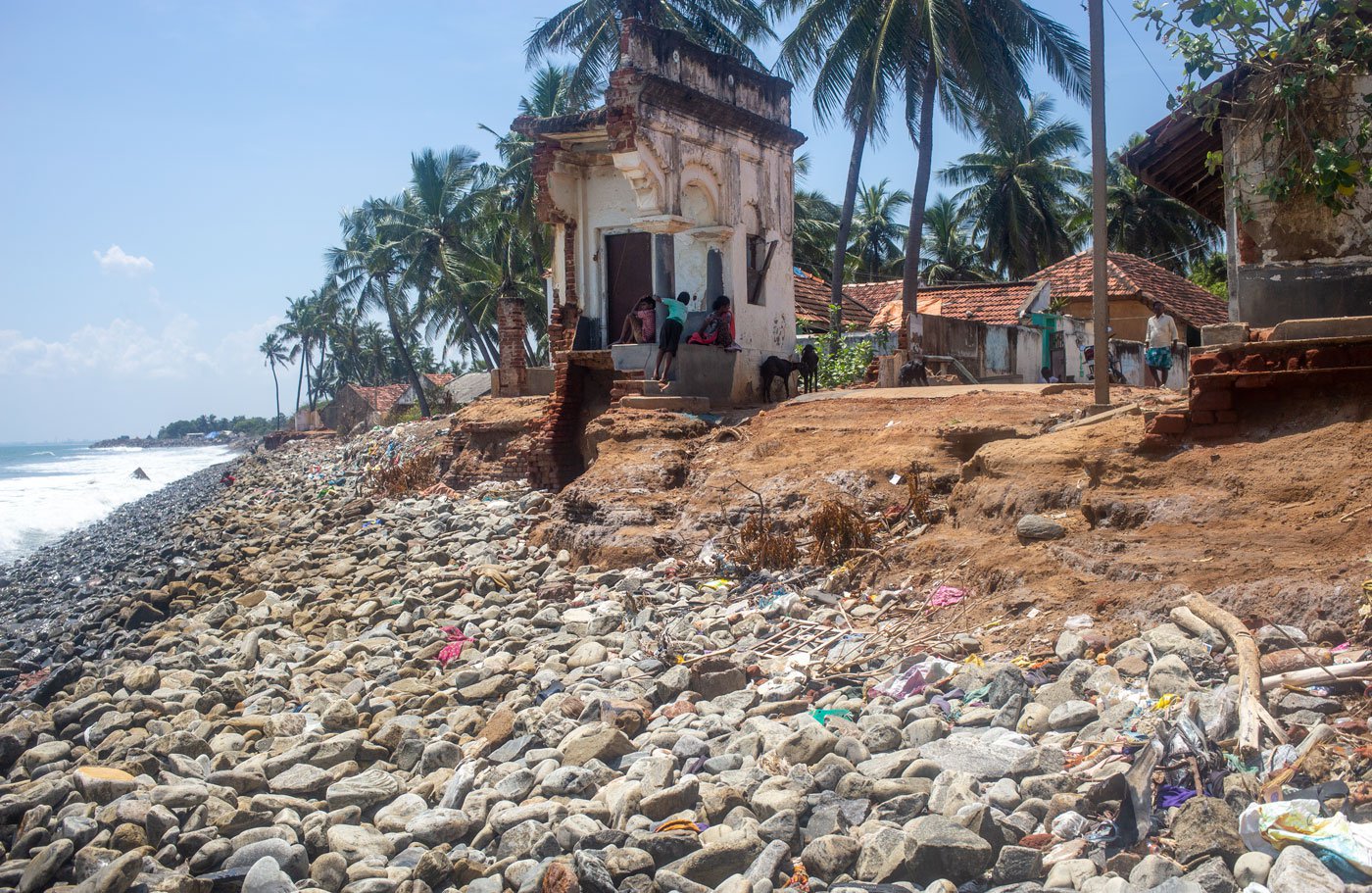
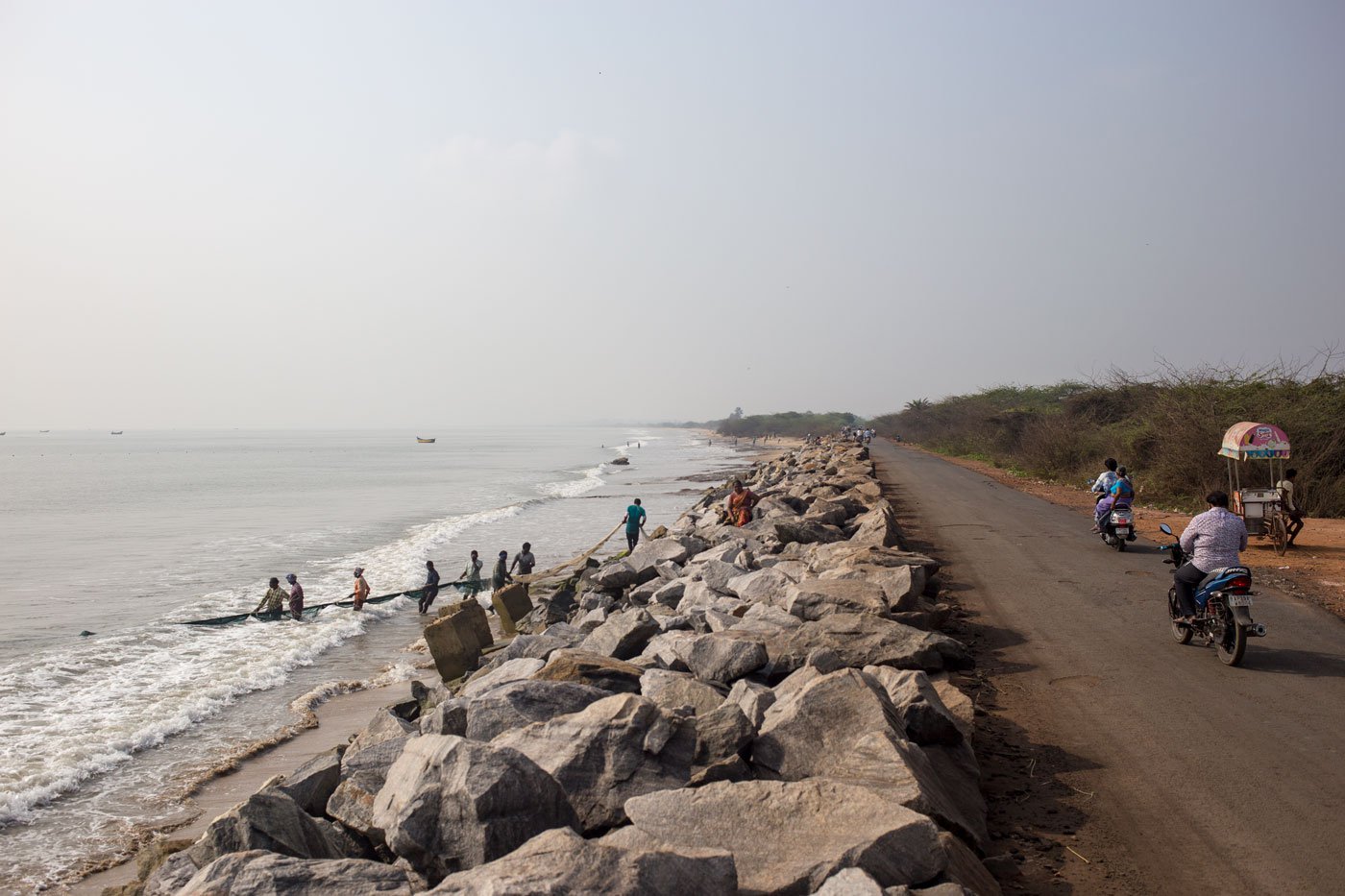
Left: Maramma’s old family home by the sea in 2019. It was washed away in 2021, in the aftermath of Cyclone Gulab. Right:
Off the Uppada-Kakinada road,
fishermen pulling nets out of the sea in December 2021. The
large stones laid along the shore were meant to protect the land from the encroaching sea
“The coastal erosion at Uppada, a few kilometres north of Kakinada town, is caused mainly by the growth of Hope Island – scientifically known as a ‘spit’ – a 21-kilometre-long linear sand body. That spit grew naturally northward from the mouth of Nilarevu, a distributary of Godavari River,” says Dr. Kakani Nageswara Rao, a retired professor of the department of geo-engineering, Andhra University, Visakhapatnam. “The waves refracted by the spit are impinging on the Uppada coast, leading to its erosion. Probably initiated more than a century ago, this sand spit more or less attained its present form in the 1950s,” explains the professor, who has been closely studying the coastal forms and processes along the Andhra coast for several decades.
Official records dating back to the early 1900s confirm that the Uppada phenomenon was already recognised more than a century ago. The Godavari District Gazetteer of 1907, for example, notes that the sea had eroded more than 50 yards of land at Uppada since 1900 – in other words, the village lost seven metres of land every year in those seven years.
“Since coastal zones in general are very dynamic regions, with the interplay of complex global, regional and local phenomena,” says Dr. Rao, “the reasons for coastal erosion at Uppada are multidimensional.” Global warming, melting polar ice caps and rising sea levels, besides increased frequency of cyclones in the Bay of Bengal, are a few of them. A drastic reduction in sediment loads at the river mouths, caused by burgeoning dams in the Godavari basin, further exacerbates the situation.
*****
As its land disappears into the sea bit by bit, Uppada gets recreated in the memory of its people.
One of the villagers asks me to watch the Telugu movie Naakuu Swatantram Vachindi for a glimpse of the village that resides in their memories and their stories. I see a different Uppada in the 1975 film: the village and the sea lie at a comfortable distance from each other, a gorgeous sandy beach separating them. The sea and sand, captured in single-frame shots — the beach was wide enough to allow the crew to shoot from various angles — form the background to key sequences in the film.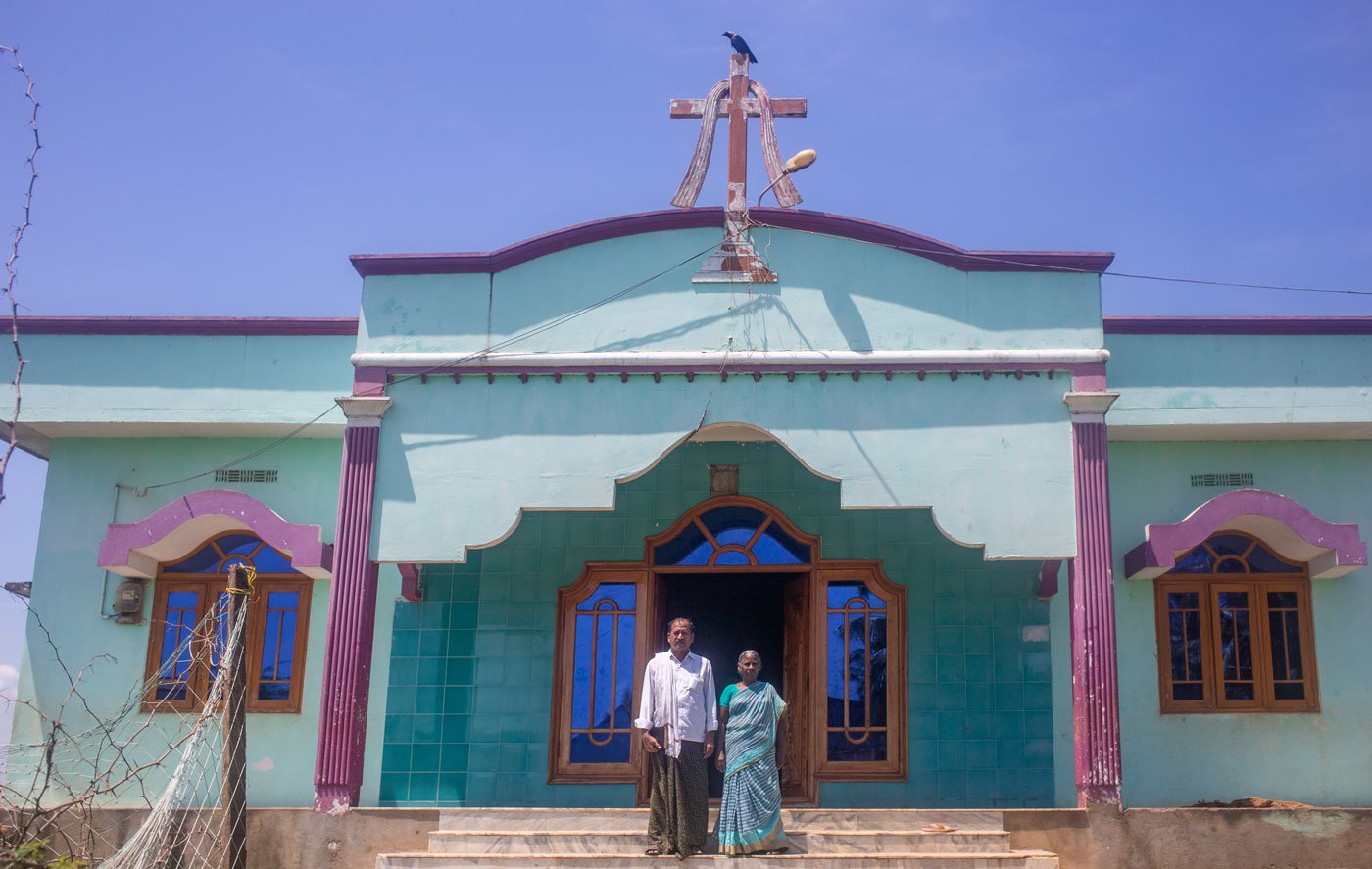
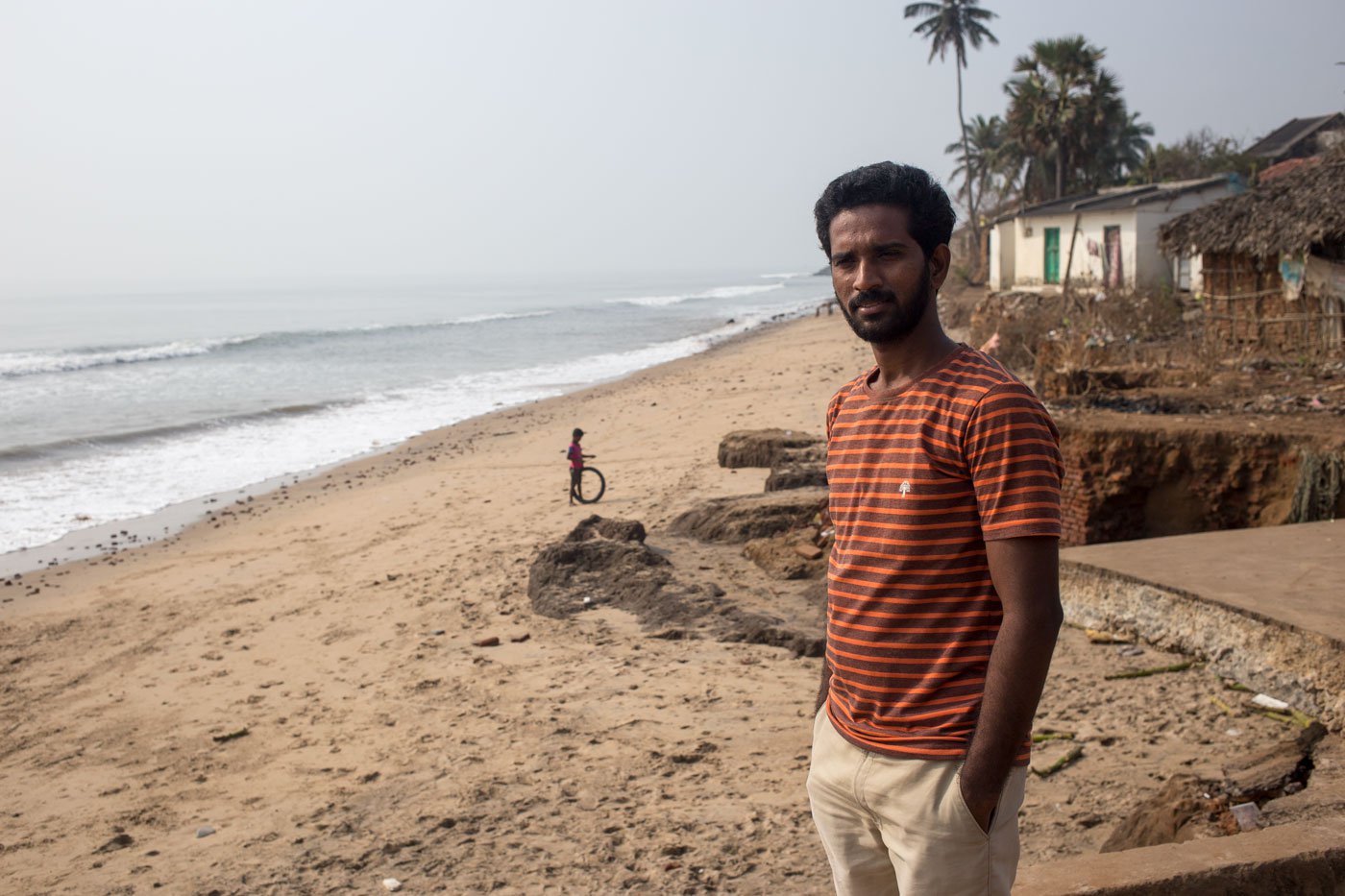
Left: Pastor S. Kruparao
and his wife, S. Satyavati,
outside their church in Uppada, in September 2019. Right: D. Prasad grew up in the coastal village, where he remembers collecting shells on the beach to sell for pocket money. With the sand and beach disappearing, the shells and buyers also vanished, he says
“I watched the shooting of the film. Some of the actors who came for the shoot even stayed in the guest house here,” says S. Kruparao, the 68-year-old pastor at a church in Uppada. “All that is in the sea now. Even the guest house.”
The District Census Handbook of East Godavari published in 1961 has a reference to a guest house, too: “There is a very comfortable Travellers Bungalow with two suites of rooms about a furlong from the sea-shore. This is said to have been built after the previous Travellers Bungalow was swallowed up by the sea.” So the guest house that the crew of Naakuu Swatantram ... occupied is at least the second one to have vanished under the waves.
The artefacts and structures taken in by the sea often resurface in archival records and in stories passed down through generations. Older villagers remember their parents or grandparents talking about a pedda rayi , a big stone, lying submerged in the sea for many years. The 1907 gazetteer describes something similar: “A ruin about half a mile out at sea still catches the fishermen's nets, and children hunt the beach at spring tides for coins which are occasionally washed up from what must be a submerged town.”
The ruin also finds a mention in the 1961 handbook : “Old fisher-folk say that sailing out in their boats or catamarans for fishing, their nets or lines are often caught by the tops of buildings or trunks of trees about a mile from the shore, and that to their own knowledge the sea has been encroaching on the village.”
The hungry sea has claimed a lot more of the village since then: almost all of its beach, countless houses, at least one temple, and a mosque. Over the last decade, the waves have also ravaged a 1,463-metre-long ‘geotube’ built in 2010 at an estimated cost of Rs. 12.16 crores to protect Uppada. Geotubes are large tubular containers filled with a slurry mix of sand and water that are used in shoreline protection and land reclamation. “In 15 years, I have seen large boulders of around two square feet melt into six-inch pebbles because of the friction of the waves,” says 24-year-old D. Prasad, a part-time fisherman who has grown up in the neighbourhood.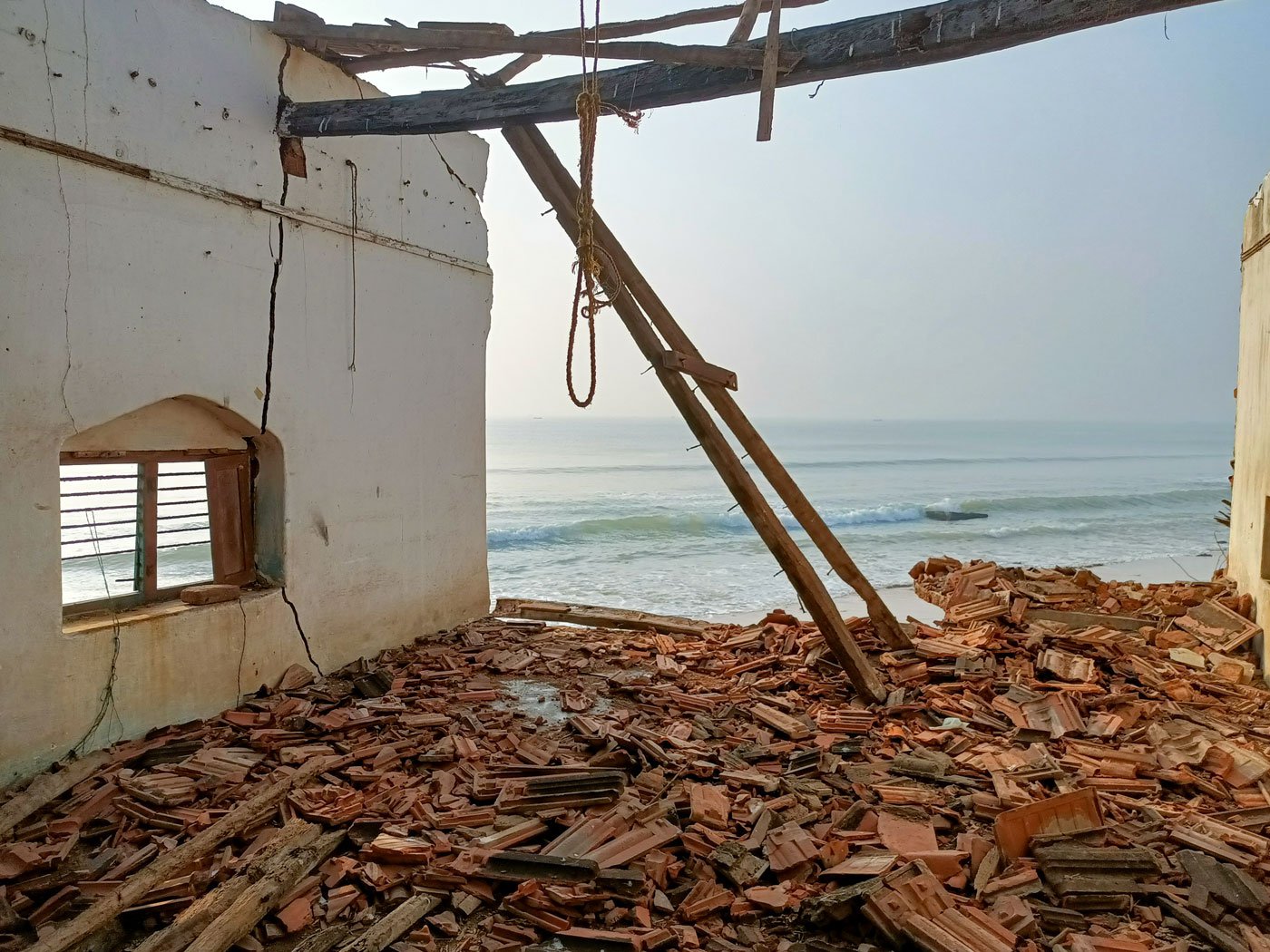
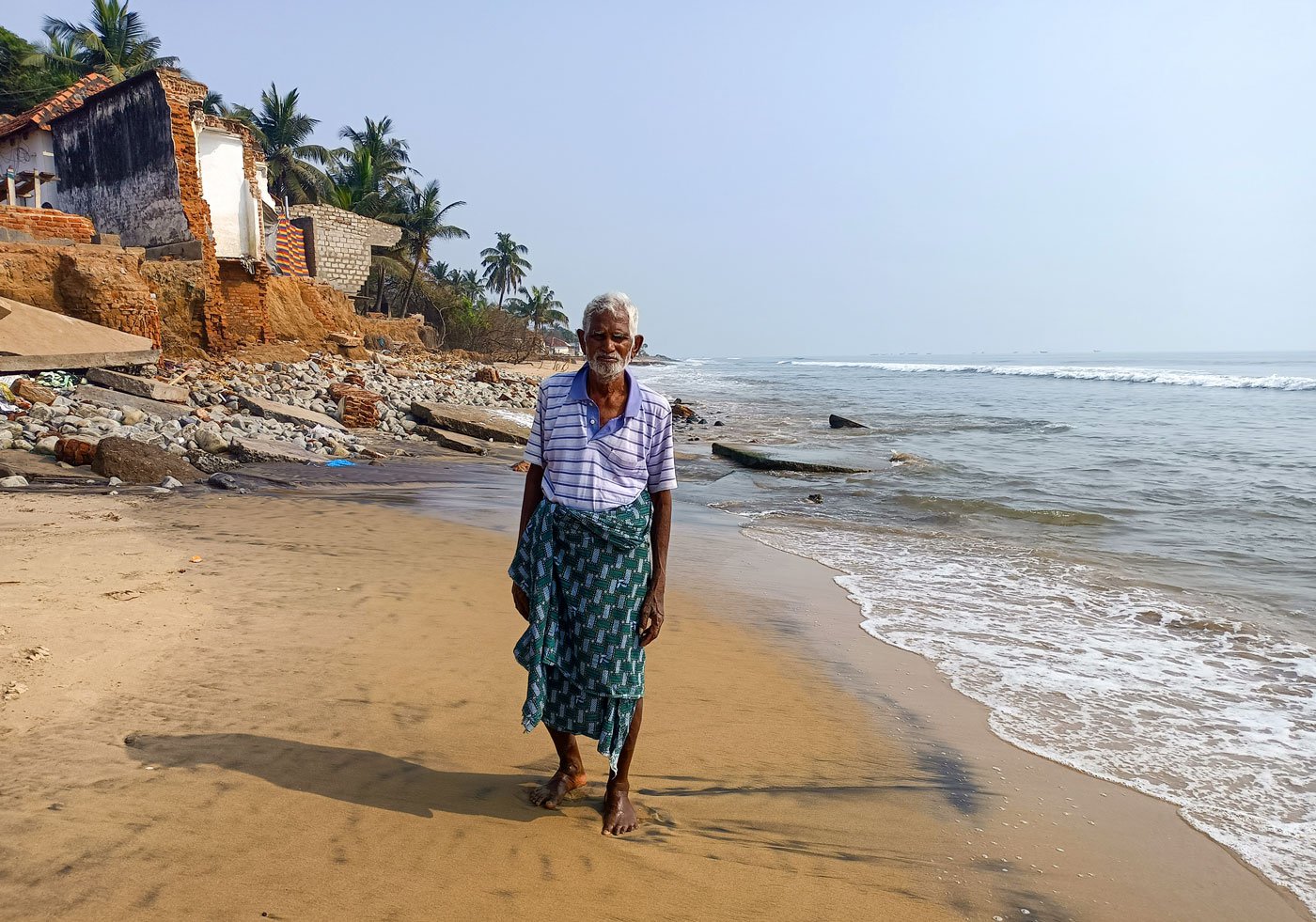
Left: Remnants of an Uppada house that was destroyed by Cyclone Gulab. Right: O. Chinnabbai, Maramma's uncle, close to where their house once stood
Uppena , a Telugu film released in 2021, captures a vastly changed Uppada, with boulders and stones along what used to be the beach, attempting to protect the village from the sea. Unlike in the 1975 film, scenes capturing the village and the sea in a single frame had to settle for bird’s eye-view shots, or diagonal shots, as there was barely any beach to place the camera on.
Perhaps the most vicious attack on Uppada’s shoreline in recent times was by Cyclone Gulab in late September 2021, when the sea took in at least 30 houses. In December, Cyclone Jawad severely damaged the newly constructed Uppada-Kakinada road, rendering it unsafe for use.
The turbulent sea in the aftermath of Gulab took away the remnants of Maramma’s old family home in early October. It also washed away the home she and her husband were living in.*****
“After the cyclone [Gulab] many of us were forced to sleep on the elevated platforms outside other people’s homes,” Maramma’s voice quivers as she recalls the devastation caused in 2021.
Since 2004, when the cyclone forced them out of their ancestral home, Maramma and her husband, T. Babai, have lived in two houses – a rented one first, and then a home of their own. Last year’s cyclone tossed that home into the sea. Today, the couple live in the open on a platform outside a relative’s house in the neighbourhood.
“At one point in time, we were a ‘ sound-party ’ [credit worthy and relatively well-off],” says Maramma. The cycle of displacement and rebuilding, combined with the wedding expenses of their four daughters, have left the family’s savings significantly depleted.
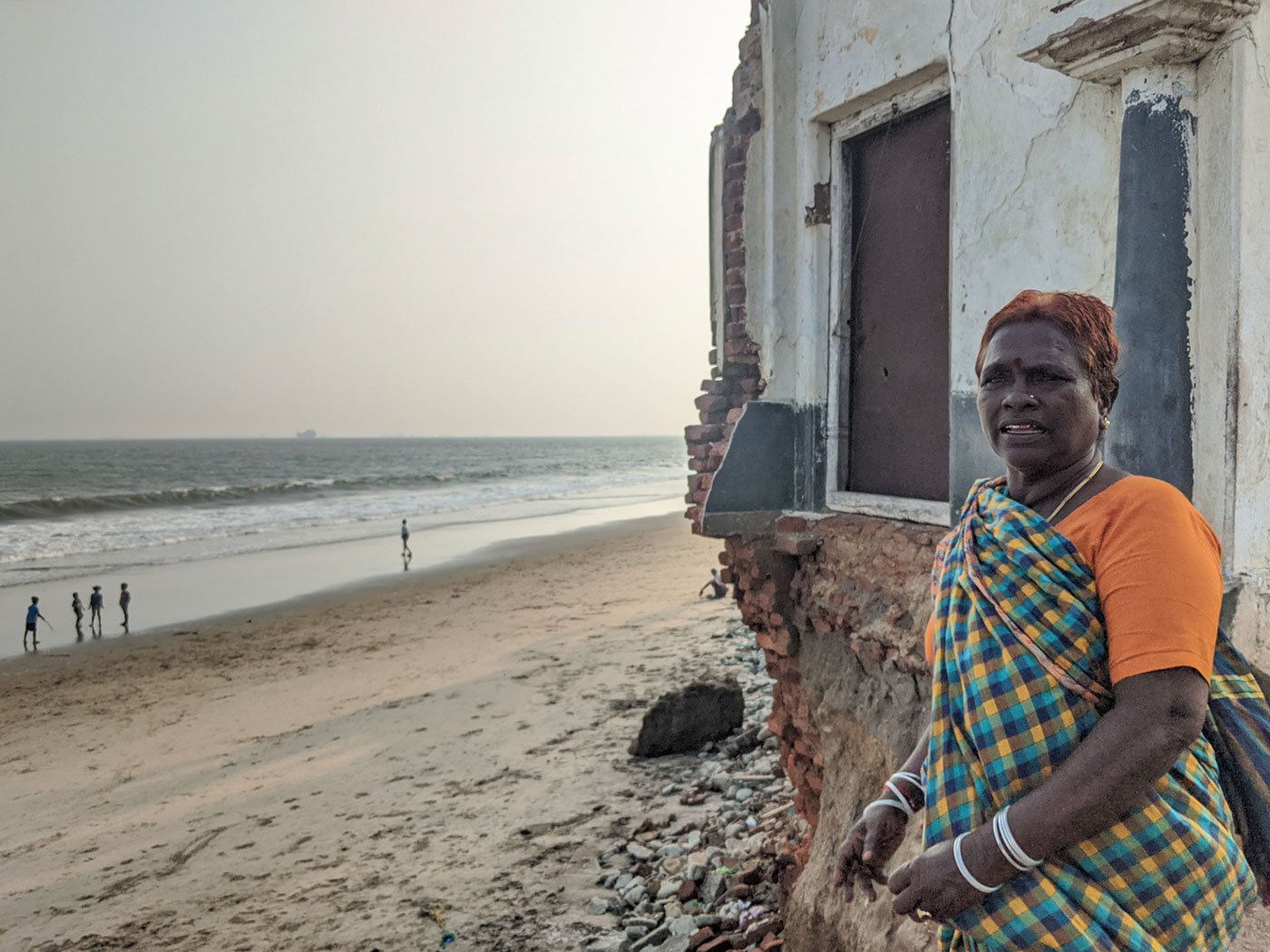
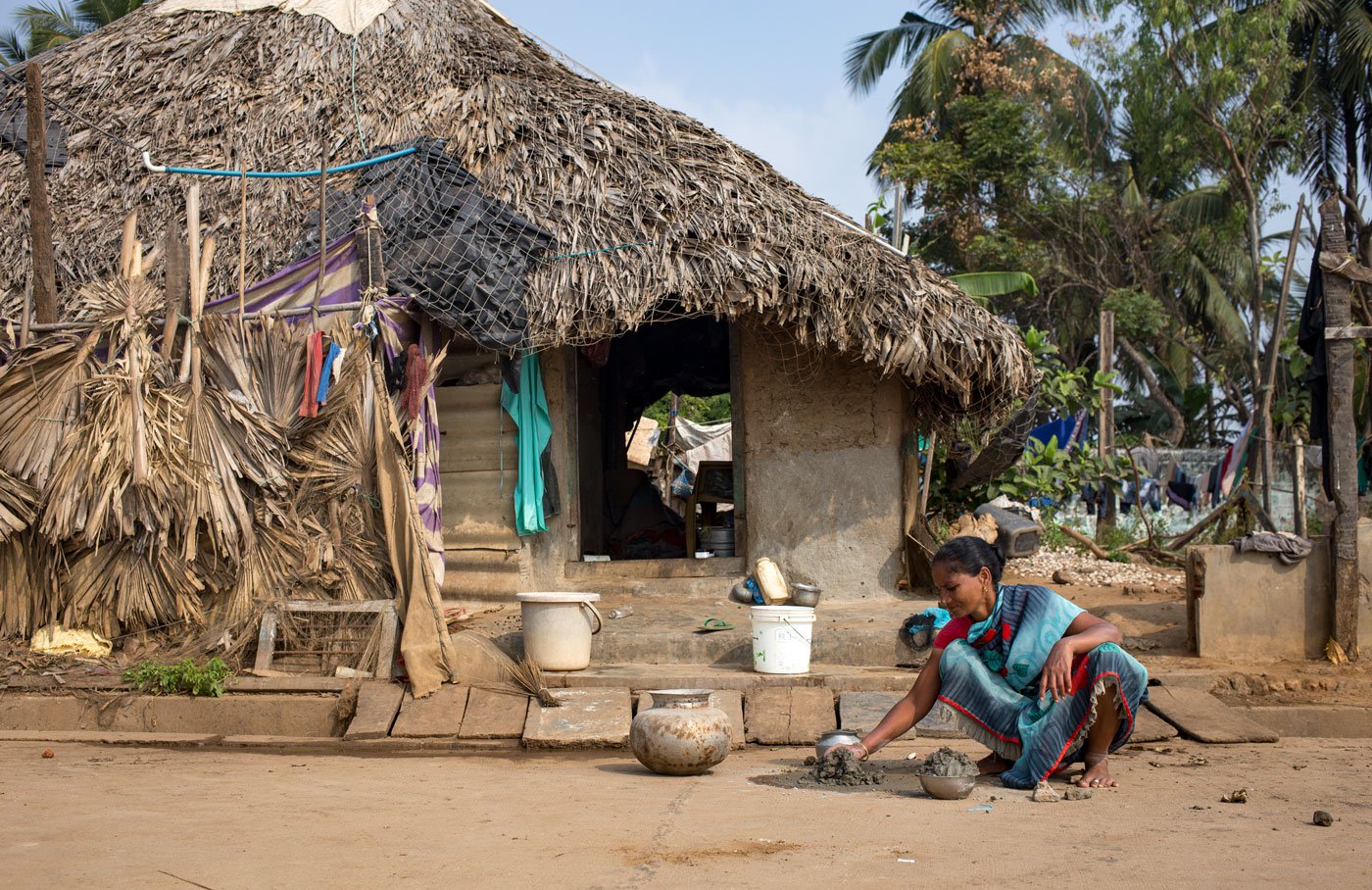
Left: Maramma's old house was a building with eight rooms. "Around a hundred people used to live here,” she says. Right: M. Poleshwari outside her third house; the first two were lost to the sea. “We take debts again and the house gets submerged again”
“We had taken loans from people to build a house, but the house got submerged,” says M. Poleshwari, from a fisher family here, echoing Maramma’s anguish. “We take debts again and the house gets submerged again.” Poleshwari has lost two houses to the sea so far. Now living in her third house, she constantly worries about her family's finances and the safety of her husband, a deep-sea fisherman. “If there is a cyclone when he goes out, he might die. But what else can we do? The sea is our only livelihood.”
Other sources of income are also drying up. Prasad remembers how, as children, he and his friends would scout the beach during low tide to collect shells, which they would sell for some pocket money. With the sand and beach disappearing rapidly, the shells also vanished; the buyers followed suit soon enough.
“We collected these shells hoping to sell them,” Poleshwari says, looking at the old shells drying in the sun outside her house. “People used to come here shouting ‘we buy shells, we buy shells’ – now they rarely come.”
After the cyclone of September 2021, Maramma and around 290 others from the fishing colony wrote to Andhra Pradesh chief minister Jagan Reddy, drawing his attention to the growing danger and distress in their village. “Earlier, Sri Y.S. Rajashekhar Reddy garu [ex-chief minister] had laid big stones along the coast of the fishing village of Uppada and saved the village from merging into the sea. These stones saved us from cyclones and tsunamis that came along,” said their letter.
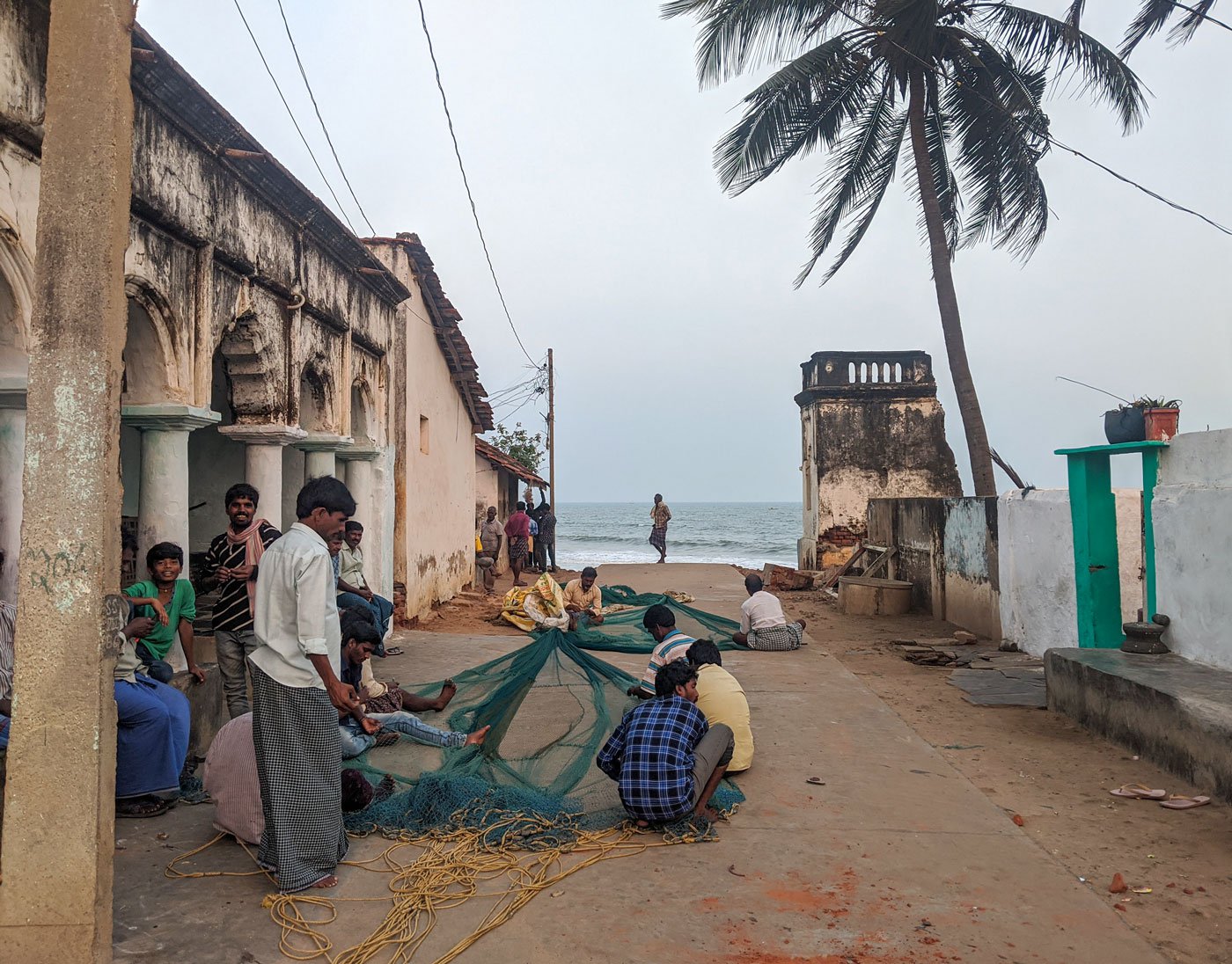
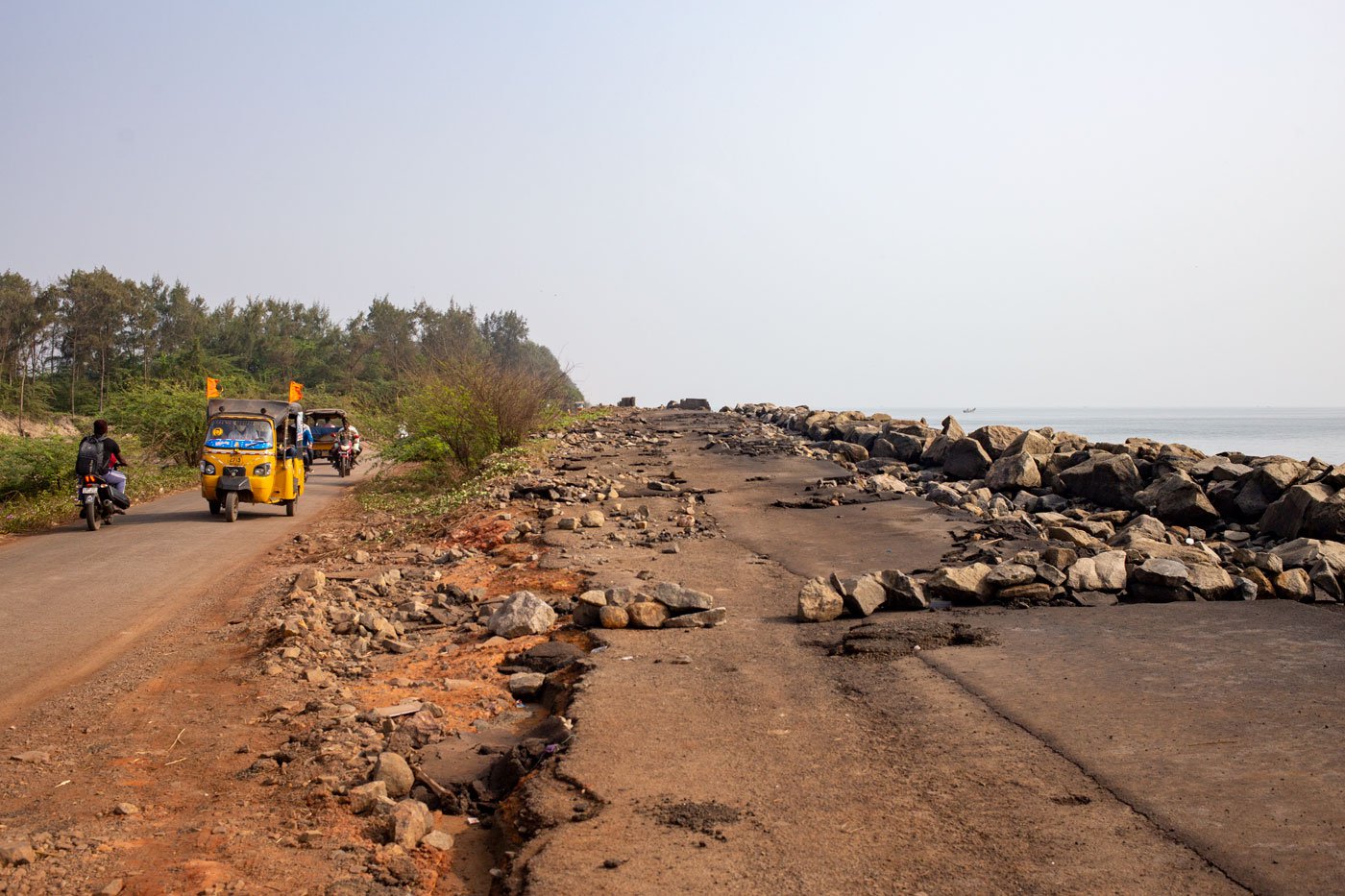
Left: The stretch from the fishing colony to the beach, in January 2020. Much of it is underwater now. Right: The Uppada-Kakinada road became unsafe after it was damaged by Cyclone Jawad in December 2021. A smaller road next to it is being used now
“Now due to the increased number of cyclones, the large stones on the shore have been displaced and the bank is destroyed. The rope that binds the stones is also worn out. So, the houses and huts lining the shore have become one with the sea. The fishers along the coastline are living in terror,” they added, requesting that the boulders be replaced with bigger ones.
However, according to Dr. Rao, there is little evidence that the boulders can provide a permanent defence against a determined sea; they are at best a makeshift remedy as the sea continues to encroach. “Don’t try to protect property. Protect the beach. The beach protects your property,” he says. And adds that “offshore barriers in the sea – like the huge stone structures which break the waves off Japan’s Kaike coast – can help prevent erosion at Uppada.”
*****
Even as the sea chips away at it, the village is witnessing changes in its social makeup. In the 1980s, the weaving community – Uppada is famous for its exquisite handwoven silk sarees – moved from the edge of the village to its interior parts after the government allotted them some land there. Gradually, the more affluent villagers, mainly belonging to the upper castes, also started moving further away from the sea. But the fishing community, their livelihoods inextricably linked to the sea, had no choice but to stay put.
With the upper castes escaping to safer areas, some of the customs and practices associated with the caste system began to weaken; for instance, the fishing community was no longer forced to hand over their catch, free of cost, for upper caste festivities. Slowly, the fishing community started turning to Christianity. “Many joined the religion for their freedom,” says Kruparao, the pastor. Most people here are very poor and belong to social groups originally categorised as Backward Classes. Kruparao remembers experiencing multiple instances of caste humiliation before embracing Christianity.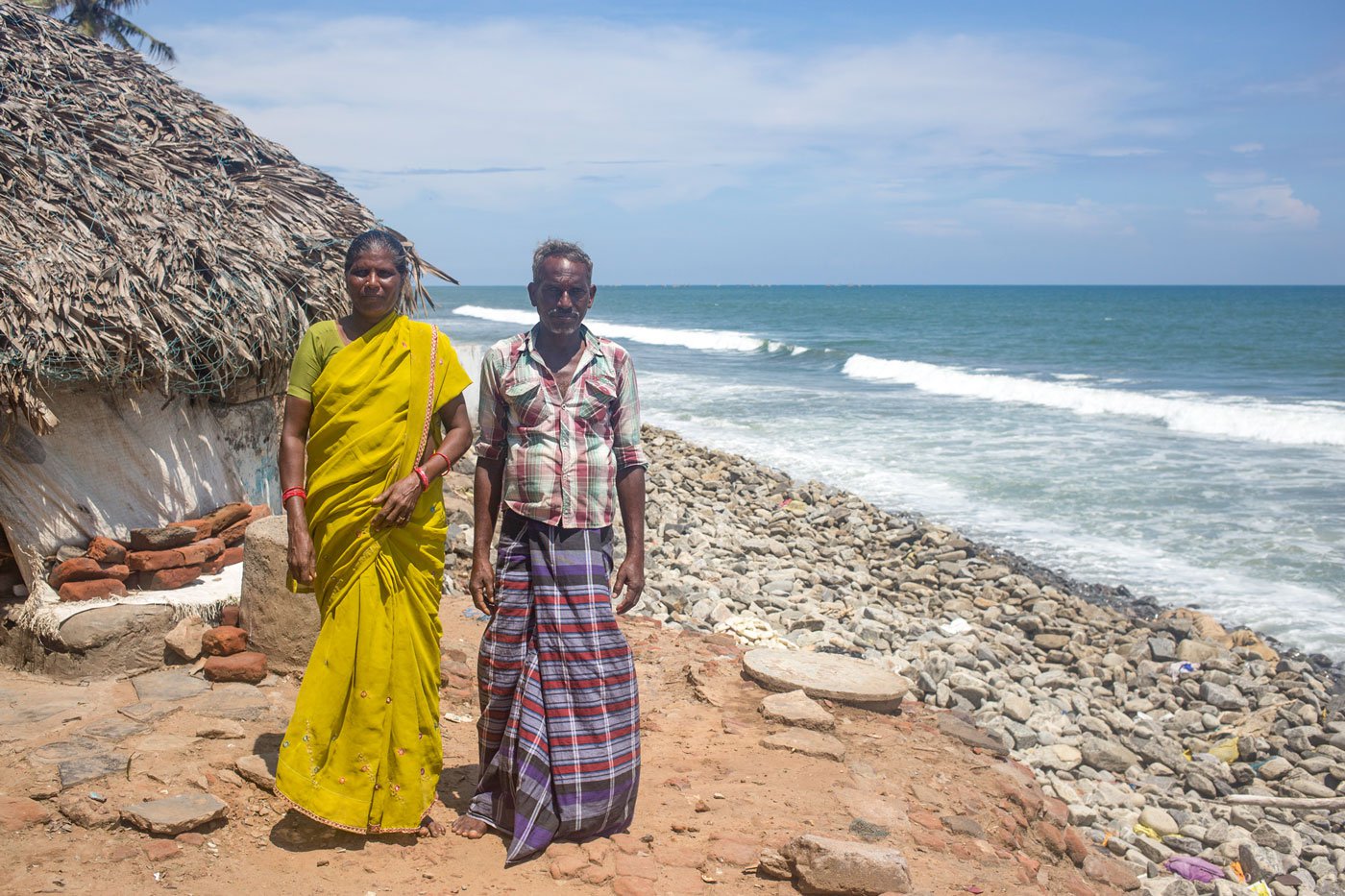
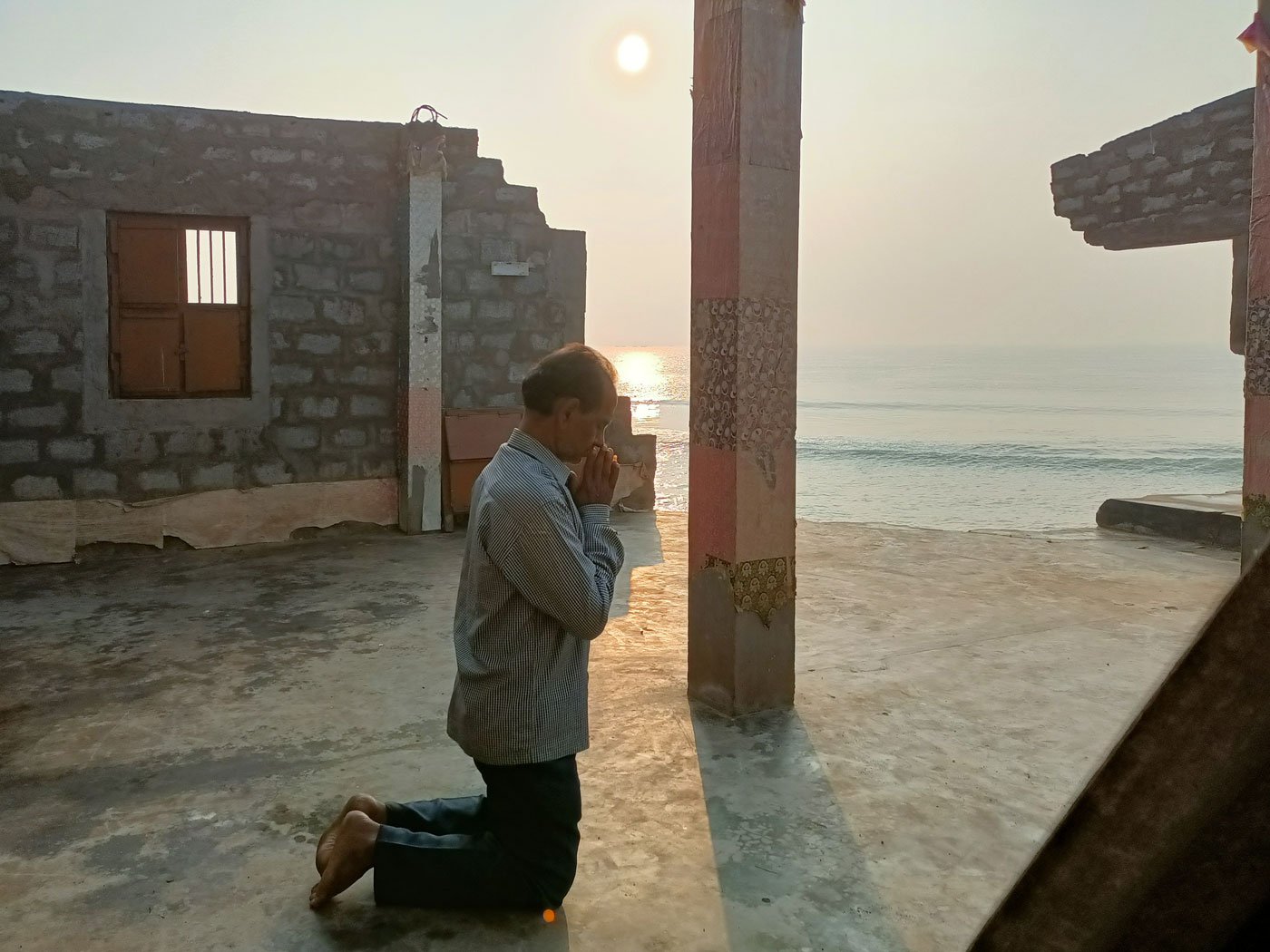
Left: K. Poleru and K. Krishna outside their home, in 2019. The structure was washed away in 2021 after Cyclone Gulab struck the coast. Right : The cyclone also wrecked the fishing colony's church, so prayers are offered in the open now
“Around 20-30 years ago, most of the villagers were Hindus. The village regularly celebrated festivities for the local goddess,” says Chinnabbai’s son, O. Durgayya. “Now most of the village is Christian.” A neighbourhood that, until the 1990s, used to take its weekly off on Thursdays [to pray to the goddess], now takes Sundays off to go to church. Villagers say there were a handful of Muslims in Uppada a few decades ago, but many of them moved out after the local mosque was submerged.
For those who stay back in the village, the signs and lessons for survival come from the encroaching sea itself. “[Danger] is recognisable; the stones begin to make a peculiar
ghollughollu
sound. Earlier, we would look at the stars [to predict the pattern of the waves]; they would shine differently. Now the mobile phones tell us this,” K. Krishna, a fisherman, had told me when I met him during my first trip here in 2019. “Sometimes, when the east wind comes from the fields, the fishermen won’t even find a rupee [i.e. fish in the sea],” his wife K. Poleru added, as the three of us listened to the waves from their hut at the edge of the fishing colony. Cyclone Gulab destroyed that hut and they have since moved to a new one.
PARI’s nationwide reporting project on climate change is part of a UNDP-supported initiative to capture that phenomenon through the voices and lived experience of ordinary people.
Want to republish this article? Please write to [email protected] with a cc to [email protected]
